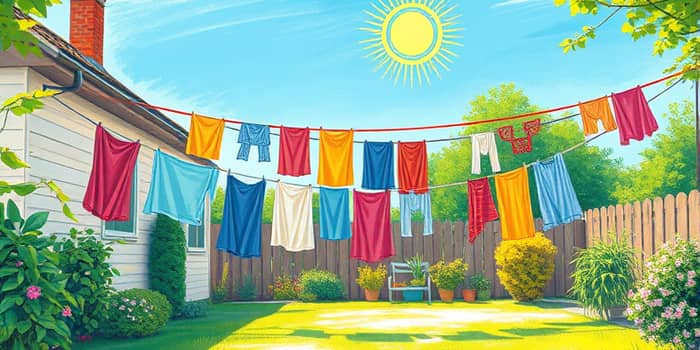Do you ever pause to think about the hidden energy costs lurking behind each load of laundry? From the roar of your dryer to the warmth of its exhaust, drying clothes can quietly drain both resources and your wallet. Yet, with a few simple adjustments and mindful choices, you can transform this daily chore into an opportunity for sustainable living. This guide will equip you with inspiring insights and practical strategies to dry your laundry intelligently, sustainably, and guilt-free.
As households around the world seek ways to reduce their environmental footprint, tackling laundry drying is a surprisingly impactful starting point. Clothes dryers rank among the most energy-intensive appliances, consuming anywhere from 1.5 to 5 kWh per load. By learning how to minimize or eliminate reliance on conventional drying methods, you can slash energy use, cut costs, and foster a healthier planet.
The Hidden Energy Cost of Drying
Standard electric dryers waste a substantial amount of energy. When you tumble dry, hot, moist air is expelled outside, often forcing your heating or cooling system to work harder to maintain indoor comfort. Over a year, a typical household can accumulate roughly 2000 kWh of dryer energy consumption—enough to light dozens of homes.
Even more efficient models like ENERGY STAR certified dryers only reduce consumption by about 20%, while heat pump dryers can save between 20% and 60% compared to conventional dryers. Still, this translates to thousands of kilowatt-hours and significant carbon emissions that could be easily avoided.
significant electricity consumption and hidden cost is the primary culprit behind high energy bills and preventable carbon output. By understanding these figures, you can appreciate the value of alternative drying solutions.
Air Drying: The Zero-Energy Solution
Air drying clothes—either outdoors on a line or indoors on racks—completely eliminates electricity use for drying. This time-honored technique not only curbs energy waste but also gently preserves fabric integrity, preventing shrinkage, color fading, and mechanical wear.
In warmer months, hanging laundry outside under the sun and breeze can be a delight. Your garments soak up fresh air, and natural sunlight helps sanitize and whiten white fabrics. But even in cooler seasons, indoor air drying remains viable and beneficial.
air drying completely eliminates energy use when done properly. Place racks near windows or vents, use fans to promote airflow, and keep clothes spaced apart. These small adjustments expedite drying and prevent mildew.
Air drying indoors also offers a hidden perk: it adds moisture to dry winter air, improving comfort and reducing reliance on humidifiers. Embrace air drying as a year-round practice to enjoy consistent benefits.
Optimizing Your Washer for Faster Drying
Before any drying method, the spinning cycle of your washer plays a crucial role. High-speed spin cycles extract more water, shortening the time needed to dry garments. Some machines now boast spins up to 1600 RPM, making a significant difference.
To boost spin efficiency, avoid overloaded drums and select the highest spin speed compatible with your fabrics. Shake garments before hanging to loosen fibers, reducing folds and speeding evaporation.
maximize spin speed efficiency by following care labels for delicate items and separating heavy towels from lightweight synthetics. A well-drained load dries faster, whether on a line or in your dryer.
Maximizing Efficiency When Using a Dryer
There will be occasions when a tumble dryer is unavoidable—think rain-soaked gear or time-sensitive needs. On these days, you can still minimize energy consumption by adopting smart habits:
- Clean the lint trap after every cycle to maintain optimal airflow.
- Use wool or rubber dryer balls to separate items and reduce drying time.
- Select low heat or eco-friendly modes combined with moisture sensors.
- Always run full loads (but avoid overstuffing) for maximum efficiency.
- Give garments a final spin in the washer before transferring them to the dryer.
- Separate heavy and light fabrics to ensure even drying.
Each of these steps helps reduce energy consumption per load, saving you money and extending the life of your dryer.
Investing in High-Efficiency Appliances
If you’re planning to upgrade, look for ENERGY STAR certified washers and dryers. Modern ENERGY STAR washers can use roughly 25% less energy and nearly 35% less water than standard models, while heat pump dryers offer the highest efficiency gains through advanced technologies.
Heat pump dryers operate on a closed-loop system, reheating recycled air rather than expelling it. This closed-loop heat exchange technology delivers 20–60% energy savings compared to conventional models and reduces wear on fabrics.
Additionally, machines featuring moisture sensors automatically shut off when clothes are dry, preventing over-drying and further conserving energy. Though these appliances require a higher upfront investment, the long-term savings in utility bills and replacement costs can be substantial.
Beyond Savings: Unexpected Benefits
Reducing dryer use and air drying garments extends their lifespan by eliminating harsh tumbling and high heat exposure. Fabrics retain their shape, maintain vibrant colors, and resist pilling and shrinkage.
Plus, indoor drying brings a subtle humidity boost that is especially welcome in homes with dry winter air. You might also find that simply seeing freshly hung clothes around your living space adds a peaceful, homey ambiance.
Perhaps most powerfully, these practices help reduce your household carbon footprint. Imagine the combined impact if every household adopted guilt-free drying methods—our collective savings in energy and carbon emissions would be monumental.
Energy Use Comparison
Actionable Tips for Energy-Guilt-Free Laundry
- Wash with cold water using eco-friendly detergents.
- Run only full loads and choose quick or eco cycles.
- Use high-speed spin cycles to remove excess water.
- Hang items with space between them for better airflow.
- Flip or rotate clothes halfway through drying.
- Keep filters, vents, and lint traps clean at all times.
Conclusion: Every Load Counts
Drying laundry without energy guilt is entirely within your grasp. By embracing air drying, optimizing washer settings, and applying efficient dryer strategies, you’ll watch your energy bills fall and your appliances last longer. Whether you hang clothes under the open sky or invest in the latest energy-saving technology, each choice you make contributes to a more sustainable future. Remember, small individual actions yield significant change when multiplied across communities. Make every load a vote for the planet and feel proud about your impact.
References
- https://www.energy.gov/energysaver/laundry
- https://www.energystar.gov/productfinder/product/certified-clothes-dryers/results
- https://automaticlaundry.com/energy-saving-laundry-habits-residents-should-know/
- https://steamery.us/3-ways-to-dry-your-laundry
- https://conwaycorp.com/wash-and-save-winter-energy-efficiency-tips-for-your-washer-and-dryer/
- https://www.lenor.co.uk/en-gb/fabric-conditioner-tips/how-to-do-laundry/how-to-dry-your-clothes-in-winter
- https://www.cenhud.com/en/my-energy/save-energy-money/blog/10-tips-to-save-energy-in-the-laundry-room/










